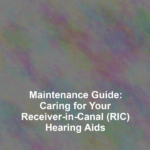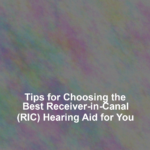Just as youG??ve come to rely on your Receiver-in-Canal (RIC) hearing aid to navigate daily conversations, it too depends on your consistent care to function at its best.
YouG??re already aware that your hearing aid is a sophisticated piece of technology, but you may not know the full extent of maintenance it requires to keep it performing optimally.
Daily cleaning is a must, of course, and youG??ll need to be vigilant about changing batteries before they completely drain. However, the nuances of managing earwax buildup and the importance of proper storage can be easily overlooked.
As you consider the longevity and effectiveness of your RIC hearing aid, remember that routine professional check-ups can catch issues you might miss.
Now, letG??s explore the steps you can take to ensure your device remains a reliable asset in your auditory arsenal, and what pitfalls to avoid that could compromise its intricate systems.
Daily Cleaning Routine
How often do you consider the daily buildup of wax and debris on your RIC hearing aid, and the impact it can have on performance? ItG??s crucial to establish a daily cleaning routine to ensure your device works effectively.
Start by gently wiping the body of the hearing aid with a dry, soft cloth to remove any dirt or moisture. DonG??t overlook the microphone portsG??use a brush specifically designed for hearing aids to clear away any particles.
Next, inspect the receiver tube for wax accumulation. If you notice any, use a wax pick or loop to carefully remove it without pushing it deeper. Remember, youG??re aiming to maintain clear sound pathways, so be meticulous but gentle to avoid damage.
Finish by checking the dome and earpiece. If theyG??re detachable, take them off and clean them with a mild, soapy solution. Rinse thoroughly and let them dry completely before reassembling.
Your hearing aid is an investment in your quality of life. By adhering to this simple cleaning routine, youG??ll prevent malfunctions and extend its lifespan. YouG??ll also enjoy clearer sound, which is, after all, the reason you chose a RIC hearing aid in the first place.
Replacing Batteries Regularly
While maintaining a clean hearing aid is essential for clear sound, regularly replacing batteries ensures your RIC device remains powered for optimal performance. Batteries in hearing aids donG??t last forever, and youG??ll find yourself needing to change them periodically. ItG??s vital to recognize when itG??s time to replace them to avoid any unexpected loss of hearing support.
HereG??s how you can stay on top of your battery game:
-
Know Your Battery Size
-
Most RIC hearing aids use zinc-air batteries.
-
Sizes include 10, 312, 13, and 675; your RIC aid will take one of these.
-
Your hearing aid will often beep or flash a light to indicate low battery.
-
You might notice a decline in sound quality or inconsistencies in performance.
To ensure youG??re never caught off guard, keep a small stock of batteries at hand. Remember, once you remove the tab, zinc-air batteries start to discharge, so donG??t peel off the tab until youG??re ready to use them. Dispose of used batteries properly, as they can be harmful to the environment. By keeping this practice, youG??ll ensure your RIC hearing aid is always ready when you need it.
Managing Earwax Buildup
To maintain your RIC hearing aidG??s performance, itG??s crucial to regularly remove earwax buildup that can muffle sound and damage the device. Earwax, or cerumen, is a natural substance that protects the ear, but when youG??re wearing a hearing aid, it can accumulate and lead to issues.
First, youG??ll want to check your hearing aid daily for any visible earwax. Use a soft, dry cloth to gently wipe the surface. DonG??t use water or any other liquids, as these can harm the electronics.
Your RIC hearing aid likely came with a cleaning tool, specifically designed for earwax removal. This tool usually has a wire loop or brush end. Carefully insert the loop into the sound outlet or vent openings to scoop out any debris. If youG??re using the brush, gently sweep away wax without pushing it further into the device.
If earwax is stubborn or compacted, consider using a wax pick or hook. Be extra cautious to avoid damaging the receiver. Never stick anything into the receiver tube itself, as this can cause irreparable harm.
Replace wax guards or filters monthly, or as recommended by your hearing care professional. These small parts prevent wax from getting into the internal components of the hearing aid.
Storing Your Hearing Aid
When youG??re not using your RIC hearing aid, store it in a dry, cool place to prevent damage and prolong its life. Moisture and heat can wreak havoc on the delicate components, so itG??s critical to find the right spot for storage.
-
Use a dehumidifier case or drying box designed for hearing aids.
-
Keep it away from direct sunlight or heat sources.
-
DonG??ts for Storing
-
Avoid leaving it in the bathroom or other humid areas.
-
DonG??t store it in a car or near a window.
Consider investing in a hearing aid dehumidifier if you live in a particularly humid climate or if you find moisture is a recurring issue. This device will help keep your hearing aid dry and functional.
Additionally, when you take your hearing aid off at night, make sure to open the battery compartment. This not only conserves battery life but also airs out the interior to prevent moisture buildup.
Scheduling Professional Check-Ups
Just as you regularly consult a doctor for your health, itG??s crucial to schedule professional check-ups for your RIC hearing aid to ensure its optimal performance. These appointments arenG??t just for when youG??ve got a problem; theyG??re preventative, too. Aim to visit your audiologist or hearing aid specialist every six months.
During these check-ups, theyG??ll do a thorough cleaning that goes beyond what you can do at home. They can reach the nooks and crannies that mightG??ve accumulated wax or debris.
Your specialist will also check for any signs of wear and tear that could affect your hearing aidG??s functionality. TheyG??ll test the components to make sure everythingG??s working as it should. If they find any issues, they can make repairs or adjustments on the spot, saving you time and the hassle of a return visit.
Conclusion
Keep your RIC hearing aids in top shape by sticking to a daily cleaning routine and swapping out batteries promptly.
DonG??t let earwax buildup interfere with performance; tackle it regularly.
Remember to store your aids safely when not in use, and donG??t skimp on professional check-ups to ensure theyG??re always working their best.
With these simple steps, youG??ll enjoy clear, uninterrupted hearing without any unnecessary hiccups.











